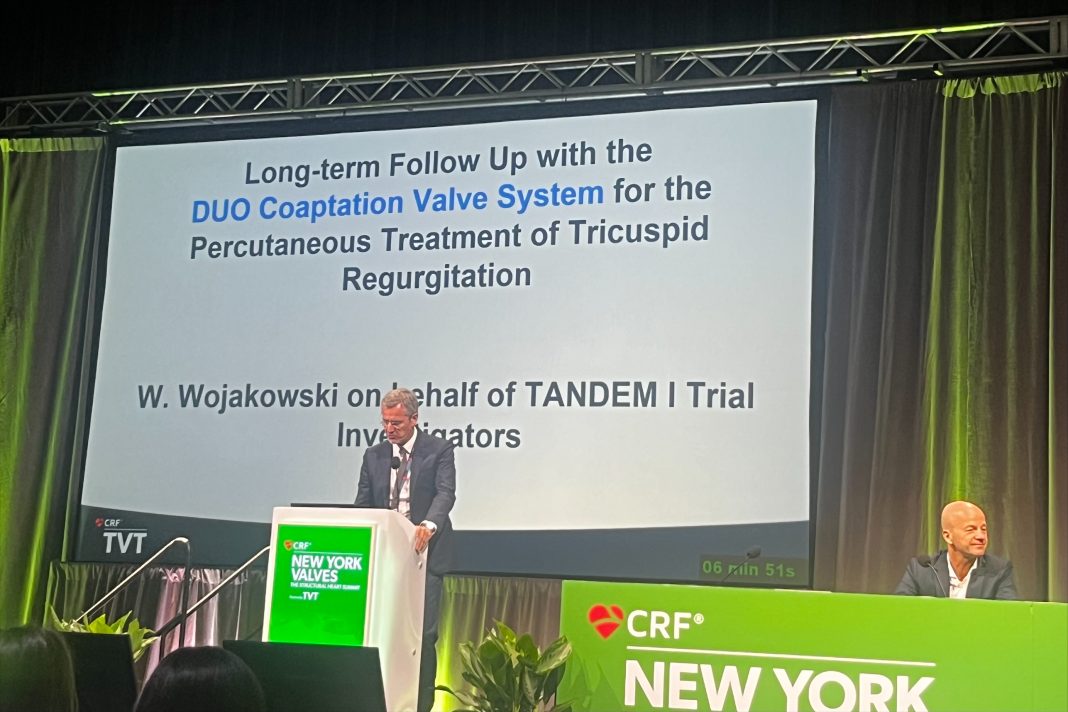Favorable patient outcomes from the TANDEM I first-in-human clinical trial of the CroíValve DUO™ System for the percutaneous treatment of tricuspid regurgitation (TR) were presented today by Professor Wojciech Wojakowski at the New York Valves 2024 scientific conference. The DUO System is a novel transcatheter coaptation valve that works in tandem with the native tricuspid valve to restore valve function, using an anchor system which leaves the right heart and native valve apparatus untouched.
TR is a severe heart condition that occurs when the tricuspid valve, on the right side of the heart, fails to close properly. This results in blood being pumped backwards into the right atrium and venous system causing debilitating symptoms. It affects over 1.6 million people in the US and is associated with significant morbidity and reduced life expectancy.
The TANDEM I trial is a prospective, non-randomized, multicenter study designed to evaluate the safety and performance of the DUO System in patients with severe symptomatic TR. The study reported on 10 patients enrolled, showing sustained positive outcomes.
Dr Martin Quinn, CMO of CroíValve
“We are encouraged by these data, which demonstrate the DUO’s success in reducing TR and improving patients’ Quality of Life. Our goal is to expand the reach of treatment option for patients with tricuspid valve disease. We are committed to building strong evidence to support emerging therapies like the DUO System, with further clinical studies and patient follow-ups underway.”
Following 30-day outcomes presented last year, the six-month results demonstrated significant TR reduction by an independent core lab assessment, with TR reduced to moderate or less in over 85% of patients, even with massive or torrential TR at baseline. Patients also experienced markedly improved functional and Quality of Life outcomes, with a notable significant increase in both KCCQ score and 6MWT over baseline. The trial reported a 100% survival rate at 6 months. No incidences of arrhythmia or conduction disorder requiring permanent pacing were reported, demonstrating the advantages of avoiding right heart contact. Additionally, this data shows stable long-term device positioning and function, while supporting natural reverse remodeling. The simplified procedural experience was highlighted by an average device time of 43 minutes, even with first use cases.
“The six-month results with the DUO System are highly promising, not only for its clinical safety and efficacy, but also for the procedure’s simplicity and the technology’s broad applicability,” stated Professor Wojtek Wojakowski, Chief, Division of Cardiology and Structural Heart Diseases at the Medical University of Silesia in Poland. “This system offers new hope for patients suffering from severe TR, providing a versatile and predictable treatment option that simplifies the procedural and imaging experience for operators.”
The DUO System is delivered using percutaneous techniques and is secured using a novel anchor system which leaves the right heart and native valve apparatus untouched. The implant procedure is straightforward, uses standard imaging and is suitable for a broad patient cohort as it is independent of annular diameter, coaptation gap, leaflet morphology and visibility.
